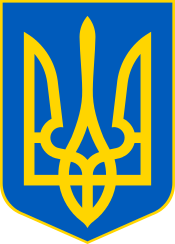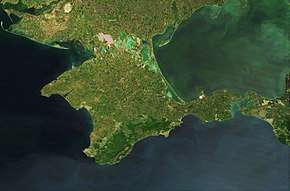Crimean Khanate
The Crimean Khanate (Crimean Tatar: Qırım Hanlığı, قرم خانلغى or Qırım Yurtu, قرم يورتى), own name — Great Horde and Desht-i Kipchak[1] (Uluğ Orda ve Deşt-i Qıpçaq, اولوغ اوردا و دشت قپچاق), in old European historiography and geography — Little Tartary (Latin: Tartaria Minor) was a Crimean Tatar state existing from 1441 to 1783, the longest-lived of the Turkic khanates that succeeded the empire of the Golden Horde. Established by Hacı I Giray in 1441, it was regarded as the direct heir to the Golden Horde and to Desht-i-Kipchak.[2][3]
Crimean Khanate | |||||||||||
|---|---|---|---|---|---|---|---|---|---|---|---|
| 1441–1783 | |||||||||||
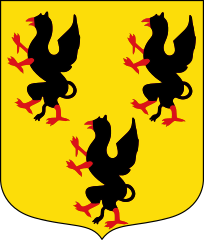 Coat of arms
 Insignia of the Giray dynasty
| |||||||||||
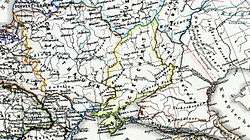 The khanate in 1550 | |||||||||||
| Status | Khanate[lower-alpha 1] | ||||||||||
| Capital | |||||||||||
| Common languages | Turki, Old Crimean Tatar, Ottoman Turkish | ||||||||||
| Religion | Islam | ||||||||||
| Government | Elective monarchy | ||||||||||
| Khan | |||||||||||
• 1441–1466 | Hacı I Giray (First) | ||||||||||
• 1777–1783 | Şahin Giray (last) | ||||||||||
| History | |||||||||||
• Established | 1441 | ||||||||||
• Annexed by Russia | 1783 | ||||||||||
| |||||||||||
| Today part of | |||||||||||
In 1783, violating the 1774 Treaty of Küçük Kaynarca (which had guaranteed non-interference of both Russia and the Ottoman Empire in the affairs of the Crimean Khanate), the Russian Empire annexed the khanate. Among the European powers, only France came out with an open protest against this act.[4]
Naming and geography
.jpg)
Crimean khans, considering their state as the heir and legal successor of the Golden Horde and Desht-i Kipchak, called themselves khans of "the Great Horde, the Great State and the Throne of the Crimea". The full title of the Crimean khans, used in official documents and correspondence with foreign rulers, varying slightly from document to document during the three centuries of the khanate's existence, was as follows: "By the Grace and help of the blessed and highest Lord, the great padishah of the Great Horde, and the Great State, and the Throne of the Crimea, and all the Nogai, and the mountain Circassians, and the tats and tavgachs, and The Kipchak steppe and all the Tatars" (Crimean Tatar: Tañrı Tebareke ve Ta’alânıñ rahimi ve inayeti milen Uluğ Orda ve Uluğ Yurtnıñ ve taht-ı Qırım ve barça Noğaynıñ ve tağ ara Çerkaçnıñ ve Tat imilen Tavğaçnıñ ve Deşt-i Qıpçaqnıñ ve barça Tatarnıñ uluğ padişahı, تنكرى تبرك و تعالينيڭ رحمى و عنايتى ميلان اولوغ اوردا و اولوغ يورتنيڭ و تخت قريم و بارچا نوغاينيڭ و طاغ ارا چركاچنيڭ و تاد يميلان طوگاچنيڭ و دشت قپچاقنيڭ و بارچا تاتارنيڭ يولوغ پادشاهى).[5][6]
According to Oleksa Hayvoronsky, the inhabitants of the Crimean Khanate in Crimean Tatar usually referred to their state as "Qırım yurtu, Crimean Yurt", which can be translated into English as "the country of Crimea" or "Crimean country".[7][8]
English-speaking writers during the 18th and early 19th centuries often called the territory of the Crimean Khanate and of the Lesser Nogai Horde Little Tartary (or subdivided it as Crim Tartary (also Krim Tartary) and Kuban Tartary).[9] The name "Little Tartary" distinguished the area from (Great) Tartary – those areas of central and northern Asia inhabited by Turkic peoples or Tatars.
The London-based cartographer Herman Moll in a map of c. 1729 shows "Little Tartary" as including the Crimean peninsula and the steppe between Dnieper and Mius River as far north as the Dnieper bend and the upper Tor River (a tributary of the Donets).[10]
The Khanate included the Crimean peninsula and the adjacent steppes, mostly corresponding to the parts of South Ukraine between the Dnieper and the Donets rivers (i.e. including most of present-day Zaporizhia Oblast, left-Dnepr parts of Kherson Oblast, besides minor parts of southeastern Dnipropetrovsk Oblast and western Donetsk Oblast). The territory controlled by the Crimean Khanate shifted throughout its existence due to the constant incursions by the Cossacks, who had lived along the Don since the disintegration of the Golden Horde in the 15th century.
History
Pre-history

The first known Turkic peoples appeared in Crimea in the 6th century, during the conquest of the Crimea by The Turkic Kaganate.[11] In the 11th century, Cumans (Kipchaks) appeared in Crimea, who later became the ruling and state-forming people of the Golden Horde and the Crimean Khanate.[12] In the middle of the 13th century, the northern steppe lands of the Crimea, inhabited mainly by Turkic peoples — Cumans, became the possession of Ulus Juchi, known as the Golden Horde or Ulu Ulus. In this era, the role of Turkic peoples increased.[13] Since this time, the local Kipchaks took the name of Tatars (tatarlar).[14][15][16][17]
In the Horde period, the khans of the Golden Horde were the Supreme rulers of the Crimea, but their governors — Emirs — exercised direct control. The first formally recognized ruler in the Crimea is considered Aran-Timur, the nephew of Batu Khan of the Golden Horde, who received this area from Mengu-Timur, and the first center of the Crimea was the ancient city Qırım (Solhat). This name then gradually spread to the entire Peninsula. The second center of Crimea was the valley adjacent to Qırq Yer and Bağçasaray.
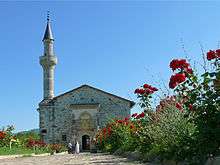
The multi-ethnic population of Crimea then consisted mainly of those who lived in the steppe and foothills of the Peninsula Kipchaks (Cumans), Crimean Greeks, Crimean Goths, Alans, and Armenians, who lived mainly in cities and mountain villages. The Crimean nobility was mostly of both Kipchak and Horden origin.[18][19]
Horde rule for the peoples who inhabited the Crimean Peninsula was, in general, painful. The rulers of the Golden Horde repeatedly organized punitive campaigns in the Crimea, when the local population refused to pay tribute. A well-known campaign of the Nogai Khan in 1299, as a result of which a number of Crimean cities suffered. As in other regions of the Horde, separatist tendencies soon began to manifest themselves in Crimea.
In 1303, in Crimea, the most famous written monument of the Kypchak or Cuman language was created (named in Kypchak "tatar tili") — "Codex Cumanicus", which is the oldest memorial of the Crimean Tatar language and of great importance for the history of Kypchak and Oghuz dialects — as directly related to the Kipchaks of the Black Sea steppes and Crimea.[20][16]

There are legends that in the 14th century, the Crimea was repeatedly ravaged by the army Grand Duchy of Lithuania. Grand Duke of Lithuania Olgerd broke the Tatar army in 1363 near the mouth of the Dnieper, and then invaded the Crimea, devastated Chersonesos and seized valuable church objects there. There is a similar legend about his successor Vitovt, who in 1397 went on a Crimean campaign to Caffa and again destroyed Chersonesos. Vitovt is also known in Crimean history for giving refuge in the Grand Duchy of Lithuania to a significant number of Tatars and Karaites, whose descendants now live in Lithuania and Belarus. In 1399 Vitovt, who came to the aid of the Horde Khan Tokhtamysh, was defeated on the banks of the Vorskla River by Tokhtamysh's rival Timur-Kutluk, on whose behalf the Horde was ruled by the Emir Edigei, and made peace.[21]
During the reign of Canike Hanım, Tokhtamysh's doughter, in Qırq-Or, she supported Hacı I Giray in the struggle against the descendants of Tokhtamysh, Kichi-Muhammada and Sayid Ahmad, who as well as Hacı Giray claimed full power in the Crimea[22] and probably saw him as her heir to the Crimean throne[23]. In the sources of the 16th—18th centuries, the opinion according to which the separation of the Crimean Tatar state was raised to Tokhtamysh, and Canike was the most important figure in this process, completely prevailed.[24]
Establishment
The Crimean Khanate originated in the early 15th century when certain clans of the Golden Horde Empire ceased their nomadic life in the Desht-i Kipchak (Kypchak Steppes of today's Ukraine and southern Russia) and decided to make Crimea their yurt (homeland). At that time, the Golden Horde of the Mongol empire had governed the Crimean peninsula as an ulus since 1239, with its capital at Qirim (Staryi Krym). The local separatists invited a Genghisid contender for the Golden Horde throne, Hacı Giray, to become their khan. Hacı Giray accepted their invitation and traveled from exile in Lithuania. He warred for independence against the Horde from 1420 to 1441, in the end achieving success. But Hacı Giray then had to fight off internal rivals before he could ascend the throne of the khanate in 1449, after which he moved its capital to Qırq Yer (today part of Bahçeseray).[25] The khanate included the Crimean Peninsula (except the south and southwest coast and ports, controlled by the Republic of Genoa & Trebizond Empire) as well as the adjacent steppe.
Ottoman protectorate

The sons of Hacı I Giray contended against each other to succeed him. The Ottomans intervened and installed one of the sons, Meñli I Giray, on the throne. Menli I Giray, took the imperial title "Sovereign of Two Continents and Khan of Khans of Two Seas."[26]
In 1475 the Ottoman forces, under the command of Gedik Ahmet Pasha, conquered the Greek Principality of Theodoro and the Genoese colonies at Cembalo, Soldaia, and Caffa (modern Feodosiya). Thenceforth the khanate was a protectorate of the Ottoman Empire. The Ottoman sultan enjoyed veto power over the selection of new Crimean khans. The Empire annexed the Crimean coast but recognized the legitimacy of the khanate rule of the steppes, as the khans were descendants of Genghis Khan.

In 1475, the Ottomans imprisoned Meñli I Giray for three years for resisting the invasion. After returning from captivity in Constantinople, he accepted the suzerainty of the Ottoman Empire. Nevertheless, Ottoman sultans treated the khans more as allies than subjects.[27] The khans continued to have a foreign policy independent from the Ottomans in the steppes of Little Tartary. The khans continued to mint coins and use their names in Friday prayers, two important signs of sovereignty. They did not pay tribute to the Ottoman Empire; instead the Ottomans paid them in return for their services of providing skilled outriders and frontline cavalry in their campaigns.[28] Later on, Crimea lost power in this relationship as the result of a crisis in 1523, during the reign of Meñli's successor, Mehmed I Giray. He died that year and beginning with his successor, from 1524 on, Crimean khans were appointed by the Sultan.
The alliance of the Crimean Tatars and the Ottomans was comparable to the Polish-Lithuanian Union in its importance and durability. The Crimean cavalry became indispensable for the Ottomans' campaigns against Poland, Hungary, and Persia.[29]
Victory over the Golden Horde
In 1502, Meñli I Giray defeated the last khan of the Great Horde, which put an end to the Horde's claims on Crimea. The Khanate initially chose as its capital Salaçıq near the Qırq Yer fortress. Later, the capital was moved a short distance to Bahçeseray, founded in 1532 by Sahib I Giray. Both Salaçıq and the Qırq Yer fortress today are part of the expanded city of Bahçeseray.
Slave trade
The slave trade was the backbone of the economy of the Crimean Khanate.[30][31] However, other historians are sure that the role of the slave trade in the economy of the Crimean Khanate is greatly exaggerated by modern historians, and the raiding economy is nothing but a historical myth.[32]
The Crimeans frequently mounted raids into the Danubian principalities, Poland-Lithuania, and Muscovy to enslave people whom they could capture; for each captive, the khan received a fixed share (savğa) of 10% or 20%. These campaigns by Crimean forces were either sefers ("sojourns"), officially declared military operations led by the khans themselves, or çapuls ("despoiling"), raids undertaken by groups of noblemen, sometimes illegally because they contravened treaties concluded by the khans with neighbouring rulers.
For a long time, until the early 18th century, the khanate maintained a massive slave trade with the Ottoman Empire and the Middle East, exporting about 2 million slaves from Russia and Poland-Lithuania over the period 1500–1700.[33] Caffa (an Ottoman city on Crimean peninsula) was one of the best known and significant trading ports and slave markets, although it could not influence Crimean Khanate economics, as Caffa was a part of Ottoman Empire, not Crimean Khanate.[34][35] In 1769, a last major Tatar raid resulted in the capture of 20,000 Russian and Ruthenian slaves.[36]
Author and historian Brian Glyn Williams writes:
Fisher estimates that in the sixteenth century the Polish–Lithuanian Commonwealth lost around 20,000 individuals a year and that from 1474 to 1694, as many as a million Commonwealth citizens were carried off into Crimean slavery.[37]
Early modern sources are full of descriptions of sufferings of Christian slaves captured by the Crimean Tatars in the course of their raids:
It seems that the position and everyday conditions of a slave depended largely on his/her owner. Some slaves indeed could spend the rest of their days doing exhausting labor: as the Crimean vizir (minister) Sefer Gazi Aga mentions in one of his letters, the slaves were often “a plough and a scythe” of their owners. Most terrible, perhaps, was the fate of those who became galley-slaves, whose sufferings were poeticized in many Ukrainian dumas (songs). ... Both female and male slaves were often used for sexual purposes.[36]
Alliances
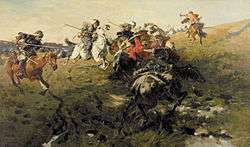
The Crimean Khanate also made alliances with the Polish-Lithuanian Commonwealth and the Zaporizhian Sich. The assistance of İslâm III Giray during the Khmelnytsky Uprising in 1648 contributed greatly to the initial momentum of military successes for the Cossacks. The relationship with the Polish-Lithuanian Commonwealth was also exclusive, as it was the home dynasty of the Girays, who sought sanctuary in Lithuania in the 15th century before establishing themselves on the Crimean peninsula.
The northern hinterlands of the khanate were coveted by Muscovy for their agricultural productivity, having longer growing seasons than Muscovy itself. Within Muscovy, the permanent warfare at the borderland and the burgeoning in size of the armies of the nobles (boyars) fomented intense exploitation of the peasantry.
Struggle over Astrakhan
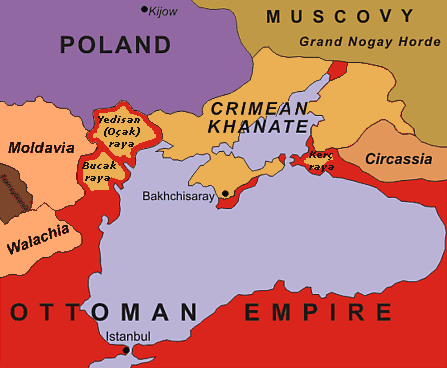
In the middle of the 16th century, the Crimean Khanate asserted a claim to be the successor to the Golden Horde, which entailed asserting the right of rule over the Tatar khanates of the Caspian-Volga region, particularly the Kazan Khanate and Astrakhan Khanate. This claim pitted it against Muscovy for dominance in the region. A successful campaign by Devlet I Giray upon the Russian capital in 1571 culminated in the burning of Moscow, and he thereby gained the sobriquet, That Alğan (seizer of the throne).[38] The following year, however, the Crimean Khanate lost access to the Volga once and for all due to its catastrophic defeat in the Battle at Molodi.
Decline
The Turkish traveler writer Evliya Çelebi mentions the impact of Cossack raids from Azak upon the territories of the Crimean Khanate. These raids ruined trade routes and severely depopulated many important regions. By the time Evliya Çelebi had arrived almost all the towns he visited were affected by the Cossack raids. In fact, the only place Evliya Çelebi considered safe from the Cossacks was the Ottoman fortress at Arabat.[39]
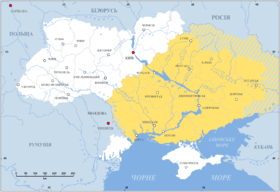
The decline of the Crimean Khanate was a consequence of the weakening of the Ottoman Empire and a change in Eastern Europe's balance of power favouring its neighbours. Crimean Tatars often returned from Ottoman campaigns without booty, and Ottoman subsidies were less likely for unsuccessful campaigns. Without sufficient guns, the Tatar cavalry suffered a significant loss against European and Russian armies with modern equipment. By the late 17th century, Muscovite Russia became too strong a power for Crimea to pillage and the Treaty of Karlowitz (1699) outlawed further raids. The era of great slave raids in Russia and Ukraine was over, although brigands and Nogay raiders continued their attacks and Russian hatred of the Khanate did not decrease. These politico-economic losses led in turn to erosion of the khan's support among noble clans, and internal conflicts for power ensued. The Nogays, who provided a significant portion of the Crimean military forces, also took back their support from the khans towards the end of the empire.
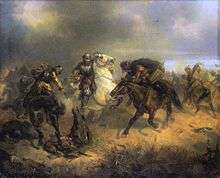
In the first half of 17th century, Kalmyks formed the Kalmyk Khanate in the Lower Volga and under Ayuka Khan conducted many military expeditions against the Crimean Khanate and Nogays. By becoming an important ally and later part of the Russian Empire and taking an oath to protect its southeastern borders, the Kalmyk Khanate took an active part in all Russian war campaigns in 17th and 18th centuries, providing up to 40,000 fully equipped horsemen.
The united Russian and Ukrainian forces attacked the Khanate during the Chigirin Campaigns and the Crimean Campaigns. It was during the Russo-Turkish War, 1735-1739 that the Russians, under the command of Field-Marshal Münnich, finally managed to penetrate the Crimean Peninsula itself, burning and destroying everything on their way.
More warfare ensued during the reign of Catherine II. The Russo-Turkish War, 1768-1774 resulted in the Treaty of Kuchuk-Kainarji, which made the Crimean Khanate independent from the Ottoman Empire and aligned it with the Russian Empire.
The rule of the last Crimean khan Şahin Giray was marked with increasing Russian influence and outbursts of violence from the khan administration towards internal opposition. On 8 April 1783, in violation of the treaty (some parts of which had been already violated by Crimeans and Ottomans), Catherine II intervened in the civil war, de facto annexing the whole peninsula as the Taurida Governorate. In 1787, Şahin Giray took refuge in the Ottoman Empire and was eventually executed, on Rhodes, by the Ottoman authorities for betrayal. The royal Giray family survives to this day.
Through the 1792 Treaty of Jassy (Iaşi), the Russian frontier was extended to the Dniester River and the takeover of Yedisan was complete. The 1812 Treaty of Bucharest transferred Bessarabia to Russian control.
Government
.jpg)
All Khans were from the Giray clan, which traced its right to rule to its descent from Genghis Khan. According to the tradition of the steppes, the ruler was legitimate only if he was of Genghisid royal descent (i.e. "ak süyek"). Although the Giray dynasty was the symbol of government, the khan actually governed with the participation of Qaraçı Beys, the leaders of the noble clans such as Şirin, Barın, Arğın, Qıpçaq, and in the later period, Mansuroğlu and Sicavut. After the collapse of the Astrakhan Khanate in 1556, an important element of the Crimean Khanate were the Nogays, most of whom transferred their allegiance from Astrakhan to Crimea. Circassians (Atteghei) and Cossacks also occasionally played roles in Crimean politics, alternating their allegiance between the khan and the beys. The Nogay pastoral nomads north of the Black Sea were nominally subject to the Crimean Khan. They were divided into the following groups: Budjak (from the Danube to the Dniester), Yedisan (from the Dniester to the Bug), Jamboyluk (Bug to Crimea), Yedickul (north of Crimea) and Kuban.
Internal affairs

Internally, the khanate territory was divided among the beys, and beneath the beys were mirzas from noble families. The relationship of peasants or herdsmen to their mirzas was not feudal. They were free and the Islamic law protected them from losing their rights. Apportioned by village, the land was worked in common and taxes were assigned to the whole village. The tax was one tenth of an agricultural product, one twentieth of a herd animal, and a variable amount of unpaid labor. During the reforms by the last khan Şahin Giray, the internal structure was changed following the Turkish pattern: the nobles' landholdings were proclaimed the domain of the khan and reorganized into qadılıqs (provinces governed by representatives of the khan).
Crimean law
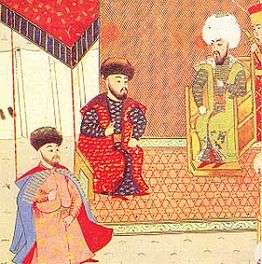
Crimean law was based on Tatar law, Islamic law, and, in limited matters, Ottoman law. The leader of the Muslim establishment was the mufti, who was selected from among the local Muslim clergy. His major duty was neither judicial nor theological, but financial. The mufti's administration controlled all of the vakif lands and their enormous revenues. Another Muslim official, appointed not by the clergy but the Ottoman sultan, was the kadıasker, the overseer of the khanate's judicial districts, each under jurisdiction of a kadi. In theory, kadis answered to the kadiaskers, but in practice they answered to the clan leaders and the khan. The kadis determined the day to day legal behavior of Muslims in the khanate.
Non-Muslim minorities

Substantial non-Muslim minorities - Greeks, Armenians, Crimean Goths, Adyghe (Circassians), Venetians, Genoese, Crimean Karaites and Qırımçaq Jews - lived principally in the cities, mostly in separate districts or suburbs. Under the millet system, they had their own religious and judicial institutions. They were subject to extra taxes in exchange for exemption from military service, living like Crimean Tatars and speaking dialects of Crimean Tatar.[40] Mikhail Kizilov writes: "According to Marcin Broniewski (1578), the Tatars seldom cultivated the soil themselves, with most of their land tilled by the Polish, Ruthenian, Russian, and Walachian (Moldavian) slaves."[36]
The Jewish population was concentrated in Çufut Kale ('Jewish Fortress'), a separate town near Bahçeseray that was the Khan's original capital. As other minorities, they spoke a Turkic language. Crimean law granted them special financial and political rights as a reward, according to local folklore, for historic services rendered to an uluhane (first wife of a Khan). The capitation tax on Jews in Crimea was levied by the office of the uluhane in Bahçeseray.[41] Much like the Christian population of Crimea, the Jews were actively involved in the slave trade. Both Christians and Jews also often redeemed Christian and Jewish captives of Tatar raids in Eastern Europe.[36]
Economy

by Daniel Schultz.
The nomadic part of the Crimean Tatars and all the Nogays were cattle breeders. Crimea had important trading ports where the goods arrived via the Silk Road were exported to the Ottoman Empire and Europe. Crimean Khanate had many large, beautiful, and lively cities such as the capital Bahçeseray, Gözleve (Yevpatoria), Karasu Bazaar (Karasu-market) and Aqmescit (White-mosque) having numerous hans (caravansarais and merchant quarters), tanners, and mills. Many monuments constructed under the Crimean Khanate were destroyed or left in ruins after the Russian invasion.[42] Mosques, in particular were demolished or remade into Orthodox churches.[42] The settled Crimean Tatars were engaged in trade, agriculture, and artisanry. Crimea was a center of wine, tobacco, and fruit cultivation. Bahçeseray kilims (oriental rugs) were exported to Poland, and knives made by Crimean Tatar artisans were deemed the best by the Caucasian tribes. Crimea was also renowned for manufacture of silk and honey.
The slave trade (15th-17th century) in captured Ukrainians and Russians was one of the major sources of income of Crimean Tartar and Nogay nobility. In this process, known as harvesting the steppe, raiding parties would go out and capture, and then enslave the local Christian peasants living in the countryside.[43] In spite of the dangers, Polish and Russian serfs were attracted to the freedom offered by the empty steppes of Ukraine. The slave raids entered Russian and Cossack folklore and many dumy were written elegising the victims' fates. This contributed to a hatred for the Khanate that transcended political or military concerns. But in fact, there were always small raids committed by both Tatars and Cossacks, in both directions.[44] The last recorded major Crimean raid, before those in the Russo-Turkish War (1768–1774) took place during the reign of Peter I (1682–1725).[44]
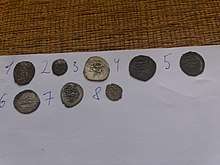
Crimean art and architecture
Selim II Giray fountain
The Selim II Giray fountain, built in 1747, is considered one of the masterpieces of Crimean Khanate's hydraulic engineering designs and is still marveled in modern times. It consists of small ceramic pipes, boxed in an underground stone tunnel, stretching back to the spring source more than 20 metres (66 feet) away. It was one of the finest sources of water in Bakhchisaray.
Bakhchisaray Fountain

One of the notable constructors of Crimean art and architecture was Qırım Giray, who in 1764 commissioned the fountain master Omer the Persian to construct the Bakhchisaray Fountain. The Bakhchisaray Fountain or Fountain of Tears is a real case of life imitating art. The fountain is known as the embodiment of love of one of the last Crimean Khans, Khan Qırım Giray for his young wife, and his grief after her early death. The Khan was said to have fallen in love with a Polish girl in his harem. Despite his battle-hardened harshness, he was grievous and wept when she died, astonishing all those who knew him. He commissioned a marble fountain to be made, so that the rock would weep, like him, forever.[45]
 Fountain of Selim II Giray
Fountain of Selim II Giray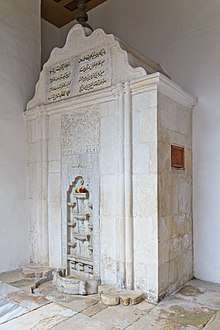 The Bakhchisaray Fountain
The Bakhchisaray Fountain
Regions and administration
- Main regions outside of Qirim yurt (the peninsula)
- Kaztsiv ulus (located in Kuban)
- Yedychkul Horde
- Djambayluk Horde
- Yedisan Horde
- Budzhak Horde
- Prohnoinsk Palanka (possibly leased to the Zaporizhian Host) (located on the Kinburn peninsula)
- Silistra Province, Ottoman Empire for sometime governed by Bakhchisaray
The peninsula itself was divided by the khan's family and several beys. The estates controlled by beys were called beylik. Beys in the khanate were as important as the Polish Magnats. Directly to the khan belonged Cufut-Qale, Bakhchisaray, and Staryi Krym (Eski Qirim). The khan also possessed all the salt lakes and the villages around them, as well as the woods around the rivers Alma, Kacha, and Salgir. Part of his own estate included the wastelands with their newly created settlements.
Part of the main khan's estates were the lands of the Kalha-sultan (Qalğa) who was next in the line of succession of the khan's family. He usually administered the eastern portion of the peninsula. Kalha also was Chief Commander of the Crimean Army in the absence of the Khan. The next hereditary administrative position, called Nureddin, was also assigned to the khan's family. He administrated the western region of the peninsula. There also was a specifically assigned position for the khan's mother or sister — Ana-beim — which was similar to the Ottomans' Valide Sultan. The senior wife of the Khan carried a rank of Ulu-beim and was next in importance to the Nureddin.
By the end of the khanate regional offices of the kaimakans, who administered smaller regions of the Crimean Khanate, were created.
- Or Qapı (Perekop) had special status. The fortress was controlled either directly by the khan's family or by the family of Shirin.
Ottoman Empire territories
- Kefe Eyalet, a seat of Ottomans in Crimea until 1774
- Silistra Eyalet, the western coast of Black Sea, later Danube Vilayet
See also
Notes
- de facto independent, de jure vassal of the Ottoman Empire from 1478 to 1774.
References
- Хакимов 2015.
- Протоколы посланий первых лиц Крымского юрта и договорных грамот ханской канцелярии. Из писем ханов Ислам-Гирея III и Мухаммед-Гирея IV к царю Алексею Михайловичу и королю Яну Казимиру "…Я, великий хан Ислам-Гирей, великий падишах Великой Орды и Великого Юрта, Дешт-Кыпчака, и престольного Крыма, и всех ногаев, и неисчислимых войск, и татов с тавгачами, и горных черкесов, да поможет Ему Аллах оставаться победителем до Судного дня, от Их величества
- Зайцев И. В., Орешкова С. Ф. Османский мир и османистика стр. 259
- Г. Л. Кессельбреннер (1994). Крым: страницы истории. М.: SvR-Аргус. ISBN 5-86949-003-0.
- Documents of the Crimean khanate from the collection of Huseyn Feyzkhanov / comp. and the transliteration. R. R. Abdujalilov; scientific. edited by I. Mingaleev. – Simferopol: LLC "Konstanta". - 2017. - 816 p. ISBN 978-5-906952-38-7
- Sagit Faizov. Letters of khans Islam Giray III and Muhammad Giray IV to Tsar Alexey Mikhailovich and king Jan Kazimir, 1654-1658: Crimean Tatar diplomacy in polit. post-Pereyaslav context. time - Moscow: Humanitarii, 2003. - 166 p. ISBN 5-89221-075-8
- Gaivoronsky Oleksa. The Country Of Crimea. Essays on the monuments of the history of the Crimean khanate. Simferopol: FL ablaeva N. F., 2016-336 p. ISBN 978-5-600-01505-0
- Oleksa Gaivoronsky. Lords of two continents, volume 1, Kiev-Bakhchisaray, 2007 ISBN 978-966-96917-1-2
- Edmund Spencer, Travels in Circassia, Krim-Tartary &c: Including a Steam Voyage Down the Danube from Vienna to Constantinople, and Round the Black Sea, Henry Colburn, 1837.
- To His Most Serene and August Majesty Peter Alexovitz Absolute Lord of Russia &c. This map of Moscovy, Poland, Little Tartary, and ye Black Sea &c. is most Humbly Dedicated by H. Moll Geographer (raremaps.com). The map shows Little Tartary as reaching the left bank of the Dnepr, and as including the Kalmius but not the Mius, to the north reaching as far as the Tor (Torets) basin, somewhat south of Izium. Other geographers (but not Moll) sometimes included in "Lesser Tartary" the territory of the Lesser Nogai Horde in Kuban, east of the Sea of Azov (in Moll's map labelled separately as Koeban Tartary).
- The Crimea. Great historical guide. Alexander Andreev publishing house Liters 2014
- "the Turkic peoples are becoming not only the ruling, but also the state-forming people" - the Golden Horde and the Slavs
- R. I. Kurteev, K. K. Choghoshvili. The ethnic term "Tatars" and the ethnic group "Crimean Tatars". - Through the ages: the peoples of the Crimea. Issue 1 \ Ed. N. Nikolaenko-Simferopol: Academy of Humanities, 1995
- see Codex Cumanicus
- Garkavets 2007.
- Géza Lajos László József Kuun, Budapest Magyar Tudományos Akadémia (1880). Codex cumanicus, Bibliothecae ad templum divi Marci Venetiarum primum ex integro editit prolegomenis notis et compluribus glossariis instruxit comes Géza Kuun. Budapestini Scient. Academiae Hung.
- Michel Balard (2017). "Генуя и Золотая Орда" (10) (Золотоордынская Цивилизация ed.): 105–112. eISSN 2409-0875. ISSN 2308-1856. Cite journal requires
|journal=(help)CS1 maint: date and year (link) - "Крымское ханство. Города и население" (in Russian). Крым.Реалии. Retrieved 2019-03-08.
- "Из истории крымтатарского народа. Кыпчаки" (in Russian). avdet.org. Retrieved 2019-03-08.
- Гаркавец А. Н. (1987). Кыпчакские языки. Алма-Ата: Наука. p. 18.
- "Наступление Тимура на Москву 1395" (in Russian). histrf.ru. Retrieved 2019-03-08.
- Герцен, Могаричев 1993, p. 63.
- Фадеева 2001.
- Герцен, Могаричев 1993, p. 65.
- Bakhchisaray history Archived 2009-01-06 at the Wayback Machine (in English)
- "Saudi Aramco World : The Palace and the Poet". archive.aramcoworld.com. Retrieved 2020-07-08.
- Khan Palace in Bakhchisaray, The Giray Dynasty Archived 2016-03-04 at the Wayback Machine, Hansaray Organization
- Bennigsen
- "WHKMLA : List of Wars of the Crimean Tatars". www.zum.de. Retrieved 2020-07-08.
- Peter B. Brown, "Russian Serfdom's Demise and Russia's Conquest of the Crimean Khanate and the Northern Black Sea Littoral: Was There a Link?", in Eurasian Slavery, Ransom and Abolition in World History, 1200–1860 (Routledge, 2015), p. 346: "The slave trade was the backbone of the Crimean khanate's economy."
- J. Otto Pohl, Ethnic Cleansing in the USSR, 1937–1949 (Greenwood, 1999), p. 110: "The slave trade formed the backbone of the Crimean Khanate's economy."
- The historical fate of the Crimean Tatars — Doctor of Historical Sciences, Professor Valery Vozgrin, 1992, Moscow (in Russian)
- Darjusz Kołodziejczyk, as reported by Mikhail Kizilov (2007). "Slaves, Money Lenders, and Prisoner Guards:The Jews and the Trade in Slaves and Captivesin the Crimean Khanate". The Journal of Jewish Studies. p. 2.
- Historical survey > Slave societies
- Caffa
- Mikhail Kizilov. "Slave Trade in the Early Modern Crimea From the Perspective of Christian, Muslim, and Jewish Sources". Oxford University.
- Brian Glyn Williams (2013). "The Sultan's Raiders: The Military Role of the Crimean Tatars in the Ottoman Empire" (PDF). The Jamestown Foundation. p. 27. Archived from the original (PDF) on 2013-10-21.
- Moscow - Historical background Archived 2007-10-11 at the Wayback Machine
- Fisher, Alan (1998). "Between Russians, Ottomans and Turks: Crimea and Crimean Tatars".
- Fisher, Alan W (1978). The Crimean Tatars. Studies of Nationalities in the USSR. Hoover Press. ISBN 978-0-8179-6662-1.
- Fisher p. 34
- A history of Ukraine, Paul Robert Magocsi, 347, 1996
- Williams
- The Russian Annexation of the Crimea 1772-1783, page 26
- Johnstone, Sarah. Ukraine. Lonely Planet, 2005. ISBN 1-86450-336-X
External links
| Wikimedia Commons has media related to Crimean Khanate. |
Further reading
- Ivanics, Mária (2007). "Enslavement, Slave Labour, and the Treatment of Captives in the Crimean Khanate". In Dávid, Géza; Pál Fodor (eds.). Ransom Slavery along the Ottoman Borders (Early Fifteenth-Early Eighteenth Centuries). Leiden: Brill. pp. 193–219.
- Дворец крымских ханов в Бахчисарае
- Дубровин Н. Ф. Присоединение Крыма к России. В 4-х тт. — СПб.: Тип. Императорской Академии наук, 1885—1889.
- Возгрин В. Е. (1992). Исторические судьбы крымских татар. М.: Мысль. ISBN 5-244-00641-X. Archived from the original on 2006-07-11. Retrieved 2020-06-01.
- Гайворонский О. Созвездие Гераев. Краткие биографии крымских ханов. — Симферополь: Доля, 2003. — ISBN 966-8295-31-5
- Базилевич В. М. Из истории московско-крымских отношений в первой половине XVII века. — Киев: Тип. 2-й артели, 1914. — 23 с.
- Бантыш-Каменский Н. Н. Реестр делам крымского двора с 1474 по 1779 год. — Симферополь: Тип. Таврическ. губернск. правления, 1893.
- Смирнов В. Д. Крымское ханство под верховенством Оттоманской Порты в XVIII в. до присоединения его к России — Одесса: Тип. А. Шульце, 1889.
- Смирнов В. Д. Крымское ханство в XVIII веке. — М.: Ломоносовъ, 2014. — ISBN 978-5-91678-230-1
- Смирнов В. Д. Сборник некоторых важных известий и официальных документов касательно Турции, России и Крыма — СПб., 1881.
- Шваб М. М. Русско-крымские отношения середины XVI — первых лет XVII веков в отечественной историографии 1940-х — 2000-х гг. — Сургут, 2011.
- Некрасов A. M. (1999). "Возникновение и эволюция Крымского государства в XV-XVI веках" (PDF) (2) (ru:Отечественная история ed.): 48–58. Cite journal requires
|journal=(help)CS1 maint: date and year (link)
- Зайцев И. В. (2010). "Крымское ханство: вассалитет или независимость?//Османский мир и османистика. Сборник статей к 100-летаю со дня рождения A.C. Тверитиновой (1910-1973)" (PDF) (Учреждение Российской академии наук, Институт востоковедения ed.): 288–297. Cite journal requires
|journal=(help)CS1 maint: date and year (link) - Гаркавец А. Н. (2007). "Codex Cumanicus: Половецкие молитвы, гимны и загадки XIII—XIV веков". Кыпчакское письменное наследие. II. Алматы: КАСЕАН; Баур. pp. 63–120.
- Зайцев И. В. (2016). "Где останавливались крымские послы в Москве и московские послы при дворе крымского хана в XVI веке?" (2). Институт истории имени Шигабутдина Марджани Академии наук Республики Татарстан: 35–51. Cite journal requires
|journal=(help)CS1 maint: date and year (link) - Хакимов Р. С. (2015). "Обращаясь к Средневековью, важно не смешивать татар и монгол" (in Russian) (1): 1. Cite journal requires
|journal=(help)CS1 maint: date and year (link) - В.В. Пенской (2010). "ВОЕННЫЙ ПОТЕНЦИАЛ КРЫМСКОГО ХАНСТВА В КОНЦЕ XV – НАЧАЛЕ XVII в?" (PDF) (2). ВОСТОК (ORIENS): 56–66. Cite journal requires
|journal=(help)CS1 maint: date and year (link) - Зайцев И. В. (2004). Между Москвой и Стамбулом (PDF). М.: Рудомино. Д. Д. Васильев. ISBN 5-7380-0202-4.
- Соловьёв С. М. (1856). История России с древнейших времён. 6, Гл. 2.
- Фадеева Татьяна Михайловная (2001). Тайны горного Крыма (Чуфут-кале и Успенский монастырь). Симферополь: Бизнес-Информ.
- Герцен А. Г., Могаричев Ю. М. (1993). Крепость драгоценностей. Кырк-Ор. Чуфут-кале (PDF). Симферополь: Таврида. pp. 58–64. ISBN 5-7780-0216-5.CS1 maint: multiple names: authors list (link)
- Фадеева Татьяна Михайловная (2007). Горный Крым (Гробница Джанике-ханым дочери хана Тохтамыша ). Симферополь: Бизнес-Информ.
- Глаголев В. С. (2018). Религия Караимов (PDF). М.: Издательство ru:МГИМО-университет.
- Домановский А. М. (2017). Секреты государственного устройства Крымского ханства: Куда ступит копыто ханского коня, то и принадлежит хану (PDF). 1. Харьков: ФОЛИО. pp. 11–16.
- Gorshenina, Svetlana. (2014). L'invention de l'Asie centrale: histoire du concept de la Tartarie à l'Eurasie. Droz. ISBN 9782600017886.
- Горский, А. А. (2010). Русское Средневековье. 1. М.: Олимп. p. 40. ISBN 978-5271237867.CS1 maint: multiple names: authors list (link)
- К. А. Кочегаров (2008). Речь Посполитая и Россия в 1680-1686 годах: заключение Вечного мира (PDF). 1. М.: Индрик, Институт славяноведения Российской академии наук. доктор исторических наук Б. В. Носов. p. 230. ISBN 978-5-85759-443-8.
- Чокан Ч. В. (1984). Собрание сочинений в пяти томах. 1. Алматы: Издательство Академии наук Казахской ССР.
